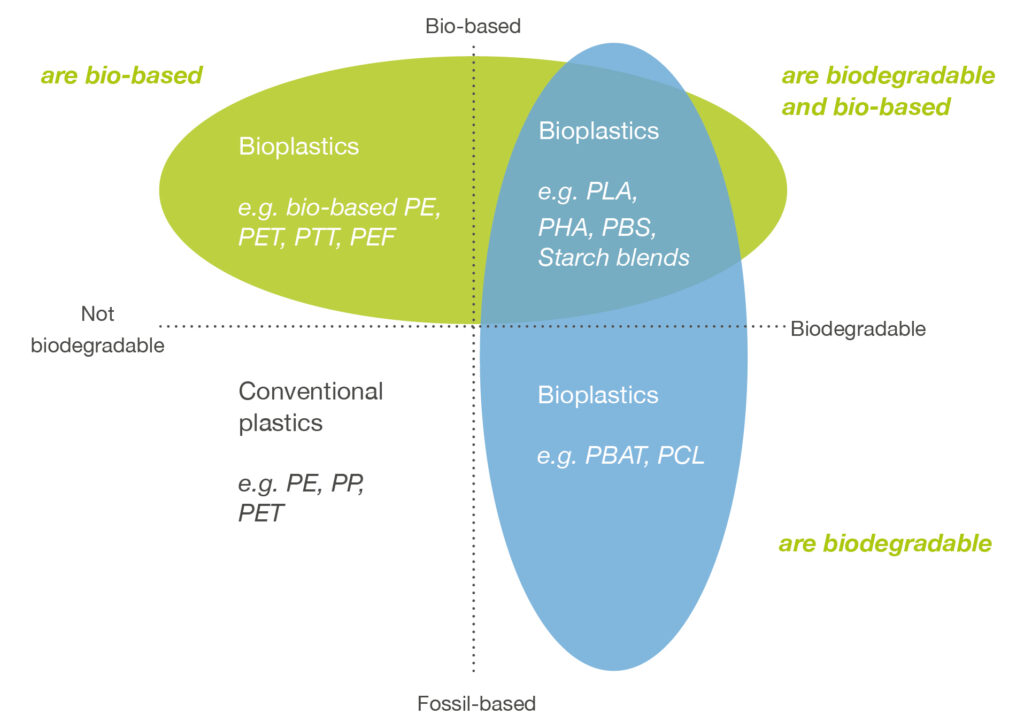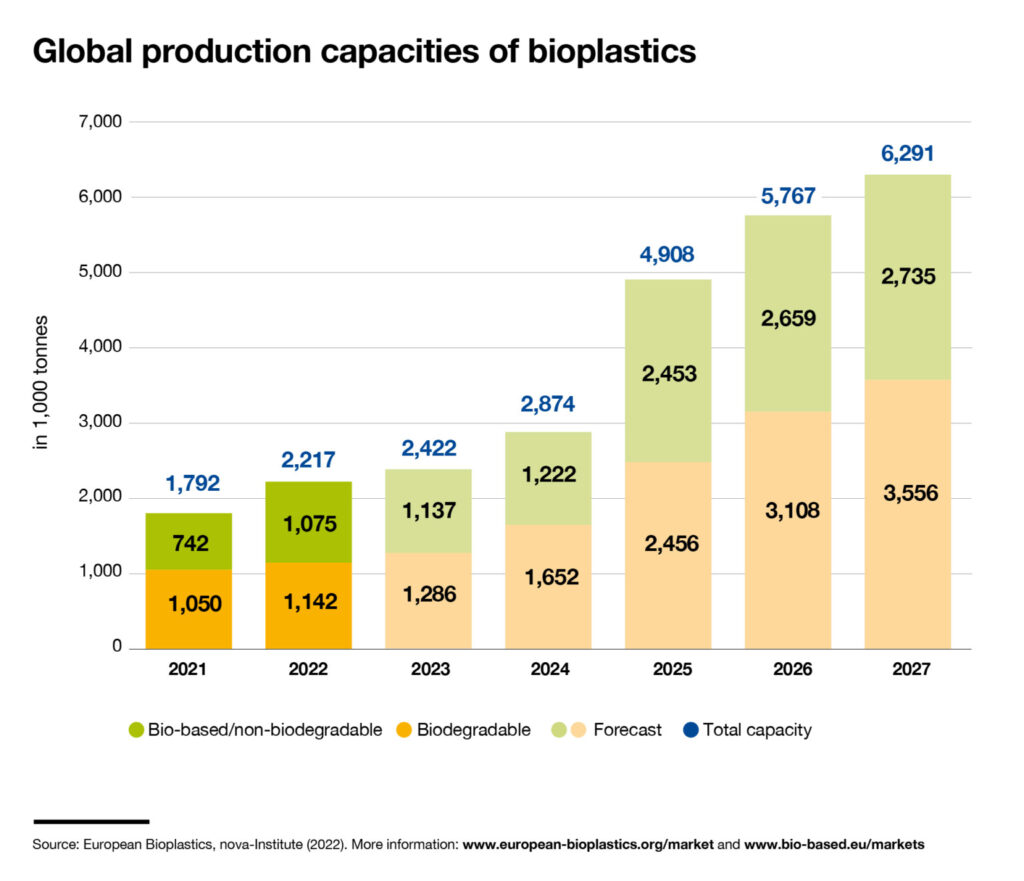I’ve written a special report about the bioplastics industry this month based on the European Bioplastics’ recent annual conference held in Berlin and the release of their industry data which was compiled by nova Institute. This report is only available for Tecnon OrbiChem’s Bio-Materials subscribers, but anybody can access the European Bioplastics Association’s press release regarding some of the industry data that they released. According to the industry trade group, global bioplastics capacity is set to increase significantly from around 2.3 million tons in 2022 to ~6.3 million tons in 2027, led by the strong development of polymers such as PHA (polyhydroxyalkanoates), polylactic acid (PLA), biobased PAs (polyamides) as well as the steady growth of biobased polypropylene (PP). The increase in capacity growth is driven by rising demand and the emergence of more sophisticated applications and products. Bioplastic alternatives exist for almost every conventional plastic material and corresponding application.
Bioplastics, which in this report encompassed bio-based/non-biodegradable and biodegradable plastics, still currently represent less than 1% of the more than 390 million tons of plastic produced annually. Asia remains in its position as a major production hub, with slightly over 40% of bioplastics currently being produced in that region. Presently, a fourth of the production capacity is still located in Europe. However, Europe’s share and the share of other world regions are expected to decrease significantly within the next five years. In contrast, Asia is predicted to have passed the 60% production market share by 2027. Officials from the European Bioplastics also noted at the conference held in Berlin, Germany, on 9th December that the projections of this global production capacity do not include announcements this year of the massive petro-based polybutylene adipate co-terephthalate (PBAT) capacity in China due to the ‘insecurity’ of these announcements.

There were also numerous PLA projects in China that were announced this year, and like PBAT, it is difficult to determine whether these announcements will come to fruition. Nova-Institute estimated this year’s global PLA capacity at almost 600 ktpa, and it is expected to surge to 2.39 million tpa by 2027. Outside of China, some of the major PLA projects worldwide announced in the past year include NatureWorks’ 75 ktpa PLA plant in Thailand; LG Chem Illinois Biochem’s planned 150 ktpa PLA plant in Illinois, USA; and TotalEnergies Corbion’s planned 100 ktpa PLA capacity in Grandpuits, France. This month, Futerro just announced its planned 75 ktpa fully integrated biorefinery in the industrial and port area of Port-Jérôme, in the Caux Seine agglomeration (commune of Saint-Jean-de-Folleville), which will produce lactic acid and PLA. Futerro currently has another PLA and lactic acid plant running in Anhui Province, China, under the B&F PLA joint venture.
For PHA, nova-Institute estimated this year’s global capacity at 86,500 tpa, and it is expected to surge to around 560-570 ktpa by 2027. Current PHA capacities are mostly between 1ktpa and 5 ktpa. Some of the largest PHA producers worldwide include Danimer Scientific in the USA, Medpha in China, and TAIF Group in Russia. Several new PHA start-ups worldwide have been launched in the past 1-2 years.
Another interesting news published this month is a potential bio-based PET project to be located in the USA. According to an article published by Nikkei Asia on 14th December, Mitsui & Company will decide next year if it will build a bio-PET facility somewhere in Southeastern USA with a planned annual capacity of 400 ktpa. This type of bio-based plastic will be the largest production site worldwide. Investment is estimated at $550 million, and if the project goes through, the start-up of the operation is expected by 2025. Mitsui & Company reportedly signed an MOU with New Jersey-based engineering and technology firm Petron Scientech Inc. (PSI) to explore a joint venture. PSI and Mitsui plan to execute various preliminary studies on the feasibility of bio-based ethylene facilities. Areas of the study will include CI impacts via life cycle analysis (LCA), engineering design along with domestic and international supply chain & marketing opportunities. The planned facility would procure bioethanol to produce the bio-MEG monomer. Recycled-based monomers could also be added to the raw material supply chain for the production of PET.
PSI claimed that even without carbon credits, corn-based ethylene production costs in the USA for capacities between 250 ktpa and 1,000 ktpa are competitive with cracker-derived ethylene production of the same capacities that are in the USA. The company pointed out that ethanol produced from corn is the lower-cost ethanol globally, and the price of corn has remained stable compared to US ethane which has been five times more volatile than US corn for the past five years. Ethane prices are expected to reportedly increase in the coming years because of increased pressure to reduce fracking in the USA. Corn prices, meanwhile, are expected to remain relatively constant.
The announcement this month from Futerro and the possibility of a bio-PET plant in the USA were not included in the nova-Institute capacity projection for 2027. According to the European Bioplastics press release, packaging remains the largest field of application for bioplastics, with 48% (1 million tonnes) of the total bioplastics market in 2022. The data also confirms that bioplastic materials are already being used in many other sectors, and the portfolio of applications continues to diversify. Segments such as automotive and transport, agriculture and horticulture, as well as electrics and electronics, continue to increase moderately in their relative share over the next years.
It will be interesting to see how the bioplastics industry will develop in the next 3-5 years.
To all the GCB readers, Happy New Year and we wish everyone a productive and prosperous 2023!

Discussion
Comments are closed.